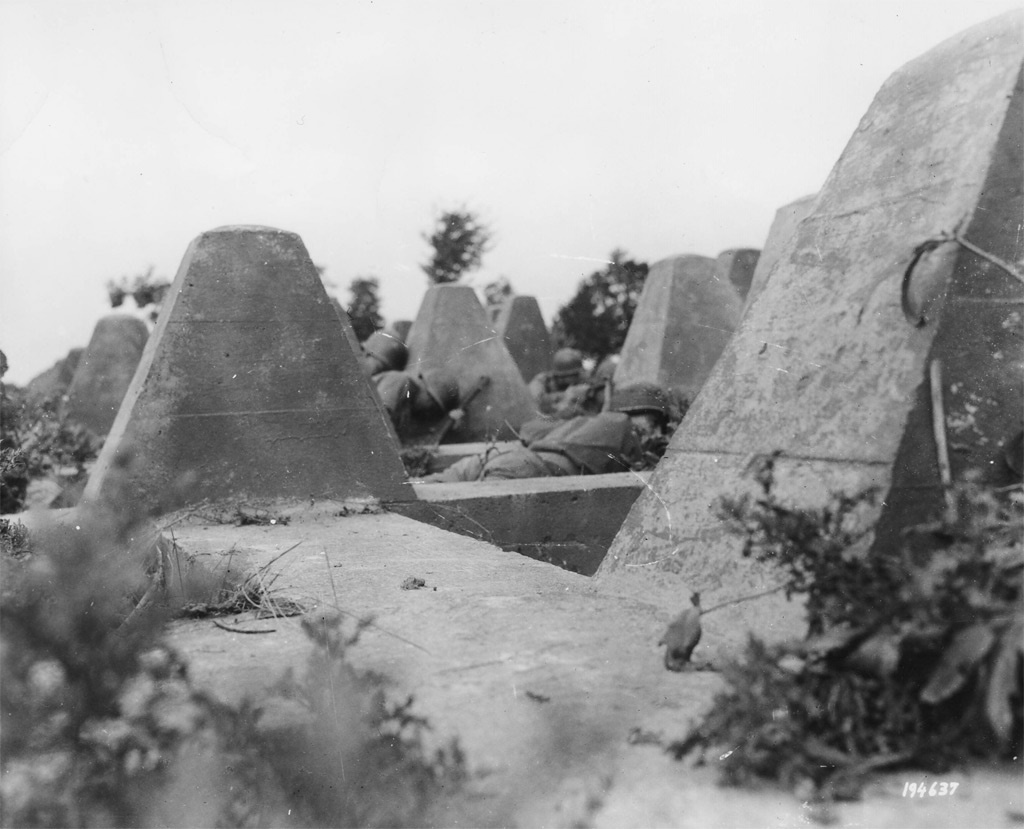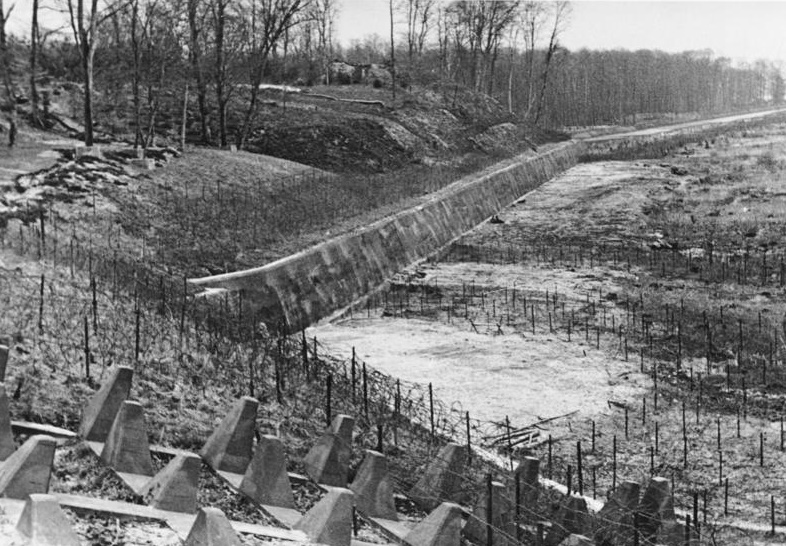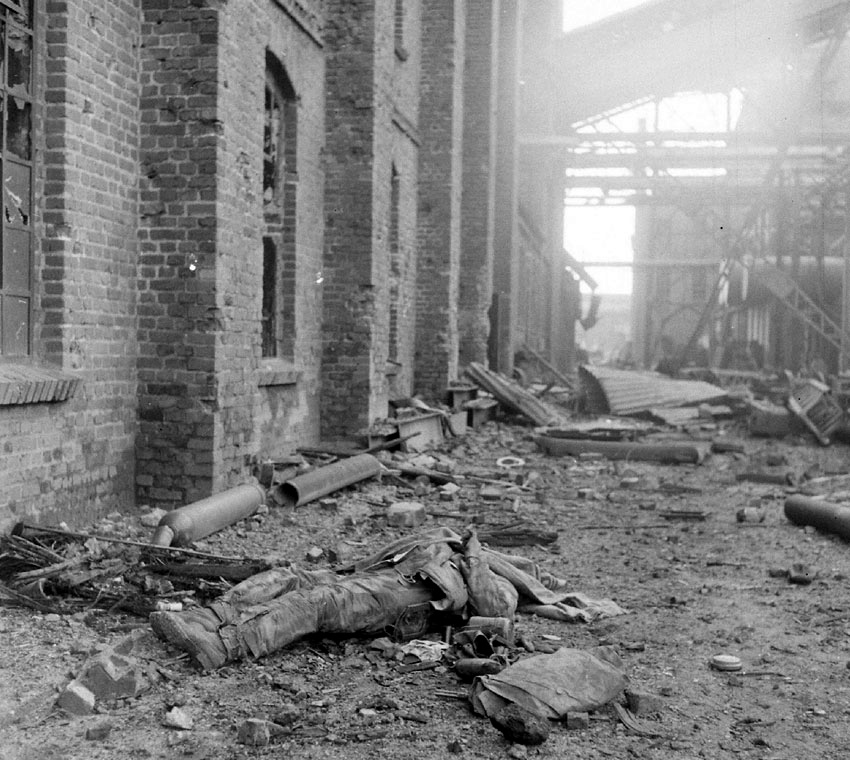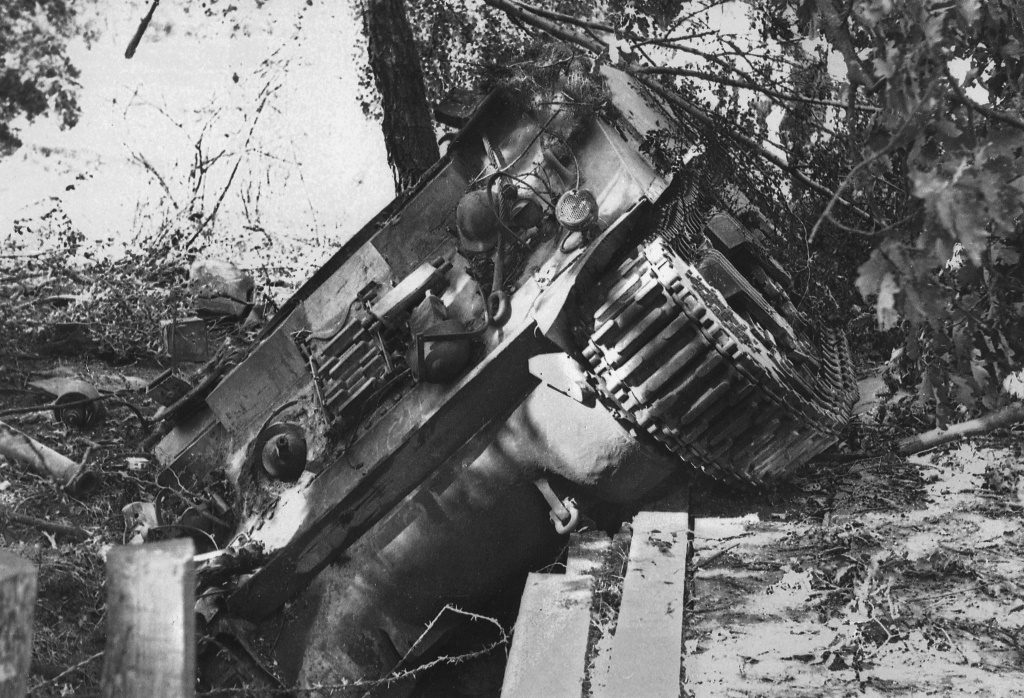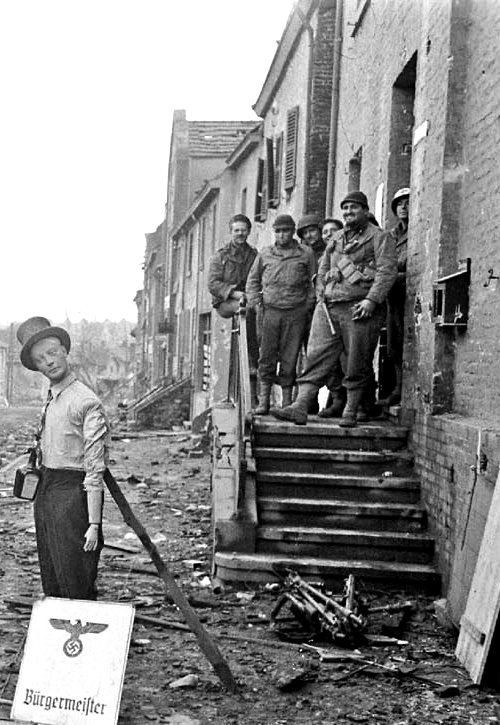In turning back the American drive on the Aachen suburb of Burtscheid, the Germans had narrowly prevented the invader from venturing into the streets of the old Imperial City for the first time. To the 116.Panzer-Division, Gen Schack relayed the Hitler order demanding the fanatic defense of Fortress Aachen In the event of an enemy penetration of Aachen, each and every house will be defended. A strategic withdrawal from the southern to the northern periphery of the city is out of the question.
 September 15, 1944, LXXXI Corps to 116. Pz Div
September 15, 1944, LXXXI Corps to 116. Pz Div
1718 Sept 15, 1944,
LXXXI Corps KTB, Befehle an Div
Shortly after midnight, on September 15, Gen Schack repeated his order to the 9.Panzer-Division that the Americans must be forced out of the second band of West Wall bunkers near Mausbach at all costs. During the remaining hours of darkness the 9.Panzer-Division made such preparations for the counter-attack as it was capable of. One replacement battalion was en route to the division; in addition, 10 tanks were moving up to the front. In the small hours of the morning, the Landesschuetzen Battalion committed on the division’s southern wing (probably 1/9) abandoned its positions; it was necessary to move up another battalion (probably the 328.Replacement-Training-Battalion) from Schevenhuette in order to plug the gap.
 September 15, 1944, LXXXI Corps to 9. Pz Div 0015 Sept 15 1944 LXXXI Corps KTB, Kampfverlauf Rad, (9. Pz Div to LXXXI Corps) 0353 Sept 15, LXXXI Corps KTB
September 15, 1944, LXXXI Corps to 9. Pz Div 0015 Sept 15 1944 LXXXI Corps KTB, Kampfverlauf Rad, (9. Pz Div to LXXXI Corps) 0353 Sept 15, LXXXI Corps KTB
Meldungen der Div
The division launched its attack against the American salient at dawn and was able to drive away US armor south of Mausbach. Some bunkers were apparently recaptured in the first assault; two bunkers remained in American hands. Two hours later the division headquarters had no news on the outcome of the counter thrust toward Vicht and Zweifall other than the report that the two bunkers south of Mausbach had not been captured yet. For the third time, the LXXXI Corps ordered the 9.Panzer-Division armor will attack the enemy and throw him back behind the West Wall. There is no time to lose. In the early afternoon, the division was able to report that as a result of its counter-attack all bunkers of the MLR from northeast of Buesbach to Zweifall were once more in German hands. An American attack on Buesbach had been repulsed by four tanks of the 105.Panzer-Brigade and four assault guns of the division’s AT Company committed there earlier in the day. The German success, however, was very short-lived. Throughout the day the 9.Panzer-Division had watched the American build-up with growing apprehension. In the early morning, the division had expressed concern about the assembly of two hundred US tanks in Kornelimuenster to which more were steadily being added. At 1500, a German runner reported a concentration of eighty US tanks in Breinig.
 September 15, 1944, LXXI Corps to 9. Pz Div
September 15, 1944, LXXI Corps to 9. Pz Div
0015 / 1500 Sept 15, 1944,
LXXXI Corps KTB, Kampfverlauf
In the early afternoon, the German attack bogged down in the face of the American artillery preparation. Under the heavy American artillery, tank, and mortar fire the division sustained serious losses and was unable to execute any movements. The Germans sensed that the American attack was imminent. At 1550, on September 15, American tanks and infantry jumped off from their assembly area at Breinig and headed for Mausbach. A furious battle ensued in which the Americans lost six tanks but were finally able to capture Mausbach and the Weissenberg Hill. An attempt to continue the drive was stopped by a German counter-attack launched from Gressenich. At 1600, the Americans threw a second punch against the 9.Panzer-Division. Forty tanks jumped off from the Eilendorf – Brander Forest assembly area and rolled east. Fifteen minutes later they faced the German obstacle wall. Although they were unable to achieve a penetration there, the 9.Panzer-Division had to report that their infantry was smashed in the Mausbach area and in the east of Eilendorf. On the extreme left, southern wing of the 9.Panzer-Division where the 328.Reserve-Training-Battalion had occupied the Scharnhorst Line, American forces also achieved a penetration at 1730, and captured one strong point. In the right and central sectors of the 9.Panzer-Division weak organic elements of the division, the 105.Panzer-Brigade and two training battalions (the 473.Reserve-Training-Battalion and the March Battalion Zorn) held the second belt of the West Wall fortifications except for the American penetrations east of Eilendorf and at Mausbach.
 September 15, 1944, Tagesmeldungen. 9. Pz Div
September 15, 1944, Tagesmeldungen. 9. Pz Div
1910 Sept 15 1944 -] LXXXI Corps
2100 Sept 15 1944, LXXXI Corps KTB
In the 116.Panzer-Division and the 9.Panzer-Division sectors the front lines had not changed much over the previous day. Nevertheless, fighting had been extremely bitter on September 15, and both sides had suffered heavy losses. The 9.Panzer-Division alone had accounted for forty-two US tanks. The Germans had also sustained serious casualties. Army Group B issued an order for all battle worthy elements of the 9.Panzer-Division still in the assembly area at St Wendel to move up to the front immediately.
 September 15, 1944, A Gp B, 1345 Sept 16, 1944, A Gp B KTB, Letzte Meldung 7.Army to LXXXI Corps (relaying Order, A Gp B to 7. Armee) 2340 Sept 15, 1944, LXXXI Corps KTB
September 15, 1944, A Gp B, 1345 Sept 16, 1944, A Gp B KTB, Letzte Meldung 7.Army to LXXXI Corps (relaying Order, A Gp B to 7. Armee) 2340 Sept 15, 1944, LXXXI Corps KTB
Befehle: Heeres-Gruppe, Armee
The LXXXI Corps Situation in Mid-September 1944
The following study of the German situation in the LXXXI Corps sector omits mention of the 275.Infantry-Division and the 49.Infantry-Division. Although subordinate to the LXXXI Corps, these divisions did not participate in operations against the US VII Corps at this time. Several days later, the 275.Infantry-Division was shifted to the southern wing of the LXXXI Corps to plug a gap between the LXXXI and the LXXIV Corps. The division will be described when it enters into this story.
On September 16, the organic fighting forces of the 116.Panzer-Division consisted of the 50.Panzer-Grenadier-Regiment, the 156.Panzer-Grenadier-Regiment and the 116.Panzer-Recon-Battalion, a total of 5 battalions with a combat strength of roughly 1600 men. The term combat strength is employed herein in translation of the German Kampfstaerke defined to include only men actually engaged in the fighting or in immediate support of front-line fighters forward of a battalion command post. The term Gefechtsstaerke, rendered as fighting strength, applies to all men who fight or support fighters forward of a regimental headquarters. See Gen Order-Nr 1/2000/44 g., 25 Apr 44, OKH/Gen Std H/Org Abt. In addition, the 12.Luftwaffe-Fortress-Battalion and the 19.Luftwaffe-Fortress-Battalion, the 453.Grenadier-Training-Battalion, and possibly other elements were attached to the division. The 302.Infantry-Training-Battalion, en route to the front, was about to join these forces under the command of the 116.Panzer-Division. Division armor on September 16, was reduced to two Mark IV (PzKpfw IV) tanks and one Mark V (Panther). The division had one assault gun left; four assault guns of the 394.Assault-Gun-Brigade were attached. Five assault guns of the 217.Assault-Gun-Brigade and elements of the 902.Assault-Gun-Brigade were en route to the division. In other, AT weapons the division possessed nine 75-MM guns of which one was self-propelled. Five additional 75-MM guns were said to be en route from Koenigsberg in East Prussia. The 116.Panzer-Artillery-Regiment had three batteries of 150-MM howitzers and one battery of 105-MM howitzers. Two other 150-MM howitzer batteries were attached – the 2.Battery, 992.Artillery-Regiment and the 3.Battery, 997.Artillery-Regiment.
 Tabulation of Armored Vehicles, 116.PD on Sep 16, 1944, and Weekly Strength Report as of 1200 on Sep 16, 1944. LXXXI Corps to 7.Army Sep 22, LXXXI Corps KTB, Befehle an Div. Tabulation: Tanks and AT Weapons LXXXI Corps, 2200 Sep 17. LXXXI Corps KTB, Tagesmeldungen. Gen Brandenberger to A Gp B Sep 16, LXXXI Corps KTB, Befehle Heeresgruppe, Army, use. FM Model to CofS, 7.Army 1350 Sep 16. LXXXI Corps to Cmdr 13. Luft Fort Bn 1850 Sep 17, and Sep 17, LXXXI Corps KTB, Kampfverlauf.
Tabulation of Armored Vehicles, 116.PD on Sep 16, 1944, and Weekly Strength Report as of 1200 on Sep 16, 1944. LXXXI Corps to 7.Army Sep 22, LXXXI Corps KTB, Befehle an Div. Tabulation: Tanks and AT Weapons LXXXI Corps, 2200 Sep 17. LXXXI Corps KTB, Tagesmeldungen. Gen Brandenberger to A Gp B Sep 16, LXXXI Corps KTB, Befehle Heeresgruppe, Army, use. FM Model to CofS, 7.Army 1350 Sep 16. LXXXI Corps to Cmdr 13. Luft Fort Bn 1850 Sep 17, and Sep 17, LXXXI Corps KTB, Kampfverlauf.
The 116.Panzer-Division also expected the 13.Luftwaffe-Fortress-Battalion and the 107.Panzer-Battalion. The latter, though intended for the Aachen sector was shifted instead to the Arnhem – Nijmegen area when Operation Market-Garden got underway. As for the 13.Luftwaffe-Fortress-Battalion (645 men), it was either never attached to the 116.Panzer-Division despite orders or remained with that division for only a few days before appearing on the roster of units of the 9.Panzer-Division. Since its arrival in the LXXXI Corps area, Gen Mueller’s 9.PD had been reinforced by additional organic units as well as by the attachment of miscellaneous other forces. On September 15, the committed organic strength of 9.PD consisted of the Battalion Schemm made up of the remaining elements of the 10.Panzer-Grenadier-Regiment and the 11.Panzer-Grenadier-Regiment. This battalion had a combat strength of 5 officers and 136 enlisted men. (Schemm seems to have been the commander of the 11.Panzer-Grenadier-Regiment.)
 Between September 11 and September 15, 1944, the following infantry battalions had been attached to the 9.Panzer-Division:
Between September 11 and September 15, 1944, the following infantry battalions had been attached to the 9.Panzer-Division:
– HQs 253. Grenadier Training Regiment
– 328. Replacement Training Battalion
– 473. Replacement Training Battalion
– Landesschuetzen Battalion I/9
– Landesschuetzen Battalion III/6
– 8. Luftwaffe Fortress Battalion
– Replacement Battalion Nagel
– Replacement Battalion Zorn
– 547. Security Battalion (Remaining Elements)
Of organic armor and AT forces, the 9.Panzer-Division had the 2.Company of the 33.Panzer-Regiment, with 15 Mark V Panthers (of which only 8 were operationally fit), elements of the 50.AT-Battalion with 6 assault guns and about 15 75-MM AT guns. Attached were the remaining elements of the 105.Panzer-Brigade with 5 Mark V Panthers and 3 assault guns, the 105.Panzer-Grenadier-Battalion, and 3 assault guns of the 394.Assault-Gun-Brigade.
In addition, the 9.Panzer-Division expected 6 assault guns of the 217.Assault-Gun-Brigade and 10 tanks which were supposed to be en route to Düren. The organic artillery of 9.Panzer-Division consisted of 2 batteries of 150-MM howitzers, the 2.Battalion of the 102.Panzer-Artillery-Regiment with 3 batteries of 5 105-MM howitzers each, + 1 reinforced battery of the 287.Flak-Battalion with 1 88-MM, 3 37-MM, and 3 20-MM AAA guns, 2 of which were quadruple-mounted. Attached to the 9.Panzer-Division’s Artillery were 1 battery of the 12.SS-Panzer-Division with 5 105-MM howitzers and the 490.Heavy-Howitzer-Battalion – 3 batteries with a total of 9 150-MM howitzers. As for engineer forces, the 2.Company of the 16.Panzer-Engineer-Battalion was also attached to the Division.














